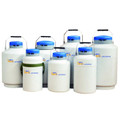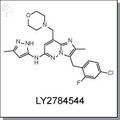 Loading... Please wait...
Loading... Please wait...- Home
- Disease Area
- Oncology
- AZ-628 | Raf inhibitor
- Home
- Molecular Target
- Ser/Thr Kinase
- TKL Kinase
- AZ-628 | Raf inhibitor
Product Description
AZ628 is a quinazolinone-based pan-Raf kinase inhibitor with IC50 values of 105, 34, and 29 nM for b-Raf, bRafV600E, and c-Raf-1, respectively. [1] It is selective over a wide panel of RTKs, including VEGFR2, DDR2, Lyn, Flt1, and FMS. AZ628 inhibits anchorage-dependent and -independent growth, causes cell cycle arrest, and induces apoptosis in colon and melanoma cell lines with the b-RafV600E mutation. Cross-reactivity profiles of AZ628 indicate similarities to sorafenib.
Typically AZ628-sensitive lines are often characterized by b-RAFV600E or NRAS mutations, while HRAS or KRAS mutations were not normally observed. AZ628 sensitivity is correlates with its abaility to suppress downstream ERK. [2]
Technical information:
| Chemical Formula: | C27H25N5O2 | |
| CAS #: | 878739-06-1 | |
| Molecular Weight: | 451.52 | |
| Purity: | > 99% | |
| Appearance: | White | |
| Chemical Name: | 3-(2-cyanopropan-2-yl)-N-(4-methyl-3-(3-methyl-4-oxo-3,4-dihydroquinazolin-6-ylamino)phenyl)benzamide | |
| Solubility: | Up to 22 mM in DMSO | |
| Synonyms: | AZ-628, AZ 628, AZ628 |
Shipping Condition: The product is shipped in a glass vial at ambient temperature.
Storage condition: For longer shelf life, store solid powder at 4oC desiccated, or store DMSO solution at -20oC.
Reference:
| 1. | Khazak et al., Selective Raf inhibition in cancer therapy. Expert Opin. Ther. Targets, 2007, 11(12), 1587-1609. Pubmed ID: 18020980 |
| 2. | McDermott et al., Identification of genotype-correlated sensitivity to selective kinase inhibitors by using high-throughput tumor cell line profiling. Proc. Natl. Acad. Sci. 104(50), 19936-19941. Pubmed ID: 18077425 |
Other Information:
Product Specification (pdf)
MSDS (pdf)
Certificate of Analysis is available upon request.















